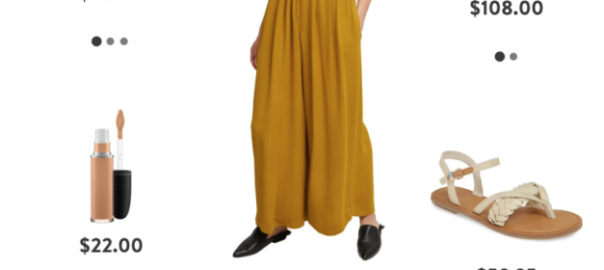— September 20, 2019
You’ve experienced cross-selling countless times in your life even if you weren’t aware of it at the time. If you’ve ever looked at an item on Amazon and seen products listed below “Customers also bought,” that’s cross-selling. And if you’ve ever had a McDonald’s cashier ask, “Would you like fries with that?” you’ve encountered it as well.
Sure, burgers and fries go together, but there’s much more to the iconic phrase than simply asking customers if they’d like a side to go with their meal. When McDonald’s began training employees to ask this question in the 1980s, the company understood the financial benefits it’d reap if more customers purchased fries. While a burger itself has slim profit margins, fries have a much larger one, so by simply paying a little more to get a side of fried potatoes, the customer was making the fast-food chain more profitable.
But cross-selling isn’t only about trying to get customers to buy your higher profit-margin items. It’s also about offering a valuable service to shoppers by helping them discover other products they might want or need and providing a positive shopping experience. This is why cross-selling for ecommerce is an effective, profit-increasing tool for every online seller.
Read on to learn how cross-selling can increase your profits and improve your customers’ shopping experience, as well as how to implement some powerful cross-selling strategies.
What is cross-selling?
Cross-selling is a sales tactic to increase sales by suggesting additional, related or complementary items to a customer.
In addition to the examples detailed above, another example of cross-selling for ecommerce can easily be found on most online retailers. If you’re ever on a product page or about to check out and see something like “Frequently bought together” with a list of additional items for you to consider purchasing, you’ve experienced cross-selling.
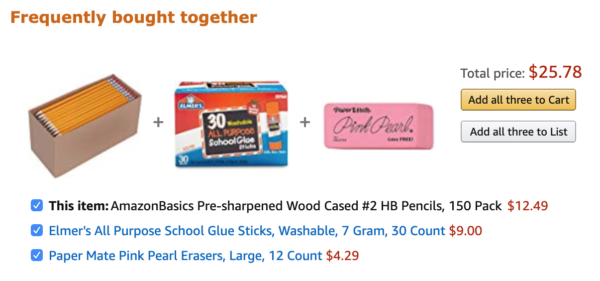
For example, adding pencils to your cart may result in the suggestion that you purchase other school supplies, such as erasers and glue sticks, as illustrated in the screenshot above.
You’ll often hear cross-selling and upselling discussed together, and sometimes the terms are used interchangeably. However, they’re two distinct sales tactics.
While cross-selling invites a customer to make an additional purchase, upselling encourages a customer to spend more for an upgraded product or premium. For example, if you’re buying a printer, an upsell may involve pitching you a more expensive printer with more features, while a cross-sell may pitch you additional products that go along with your initial purchase, such as ink cartridges or printer paper.
Another example of upselling is when you buy a domain on GoDaddy, you’re immediately given the opportunity to add a privacy-protection plan to your purchase, as illustrated below.
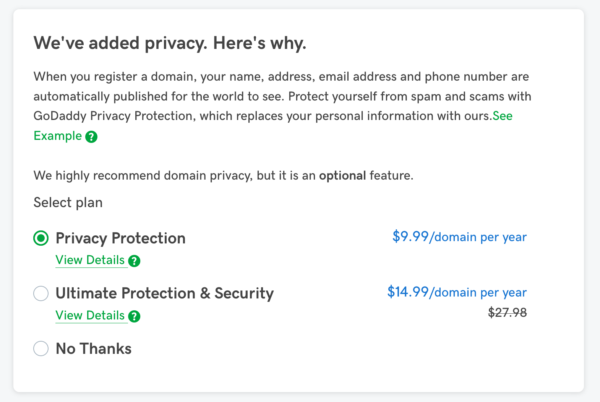
What kind of products to cross-sell
When suggesting additional items for a customer to purchase, it’s important to suggest only relevant items, such as the following:
- Related products: These are items related to the one that a customer is already purchasing. For example, if a buyer has added a cat tree to their cart, Amazon suggests also purchasing cat toys. While the toys aren’t an additional part of the cat tree and can’t be used in conjunction with it, they’re related because a cat owner may also be interested in buying additional cat products.
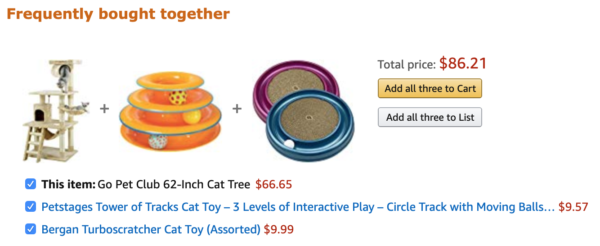
- Complementary products: These items are ones used directly with the product the user is purchasing. For example, if a customer adds a label printer to their cart, Amazon will suggest that they purchase the correct size label-printing paper to go with it.
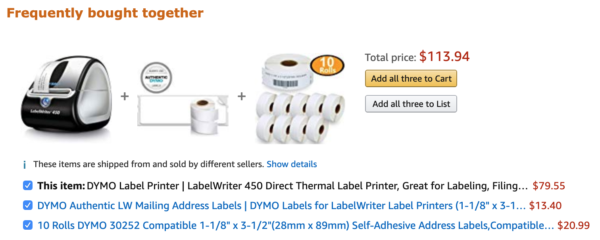
- Services: Another way to cross-sell is by offering services that customers can add to their purchase. While not every business has a service to cross-sell, services are popular options for ecommerce stores that offer warranties and protection plans, such as Best Buy.

For example, when you add a high-price item like a television set to your cart on BestBuy.com, you’ll be automatically offered the opportunity to extend and enhance the manufacturer’s warranty through Best Buy, as indicated above.
Benefits of cross-selling
There are several benefits to cross-selling for ecommerce. While the focus is typically on the opportunity to increase revenue, there are other important benefits as well, as explained below.
- Larger order size and profits: Just as McDonald’s has higher profit margins on fries, many ecommerce stores have higher margins on add-ons and accessories. By offering such items at checkout, you can increase your own profits as well. This is especially effective if you offer free or flat-rate shipping because, while the customer is purchasing additional small items, they won’t cost more to ship. Amazon, which is well-known for its free two-day shipping for Prime members, reports that cross-selling generates as much as 35% of its profits, according to Forbes.
- Increased customer value: Existing customers are easier to sell to. You’re 60-70% more likely to sell to an existing customer, compared with the 5-20% likelihood of selling to a new one. And existing customers are actually responsible for most of an ecommerce store’s profits. In fact, 40 percent of an ecommerce store’s revenue comes from only 8 percent of its customers, according to Adobe.
- Improved customer experience: Cross-selling should always help customers solve a problem. By offering shoppers additional products they may need to make their initial product work effectively — or by offering them items that would enhance that product’s use — your store performs a valuable service, which, in turn, grows customer loyalty.
When to cross-sell
While you can attempt to cross-sell at any point during the purchasing process, timing matters, so it’s important to be strategic about when you suggest other items to a customer. Too frequent or inappropriate cross-selling can frustrate visitors to your store, prompting them to abandon their carts and possibly even negatively affecting your store’s reputation.
Generally, it’s a good time to attempt to cross-sell to customers at two points during the purchasing experience: on the product page itself and during checkout.
Cross-selling on product pages
When a customer is on a product page, they’re already interested in the item, so this is a good opportunity to suggest related or complementary products. It’s a good rule of thumb to pitch products that cost 10 percent to 50 percent of the main product’s cost.
For example, on a product page for a $ 1,400 wood-burning outdoor fireplace on Wayfair, the products a customer is offered are relevant outdoor accessories at a much lower price point, as illustrated below.
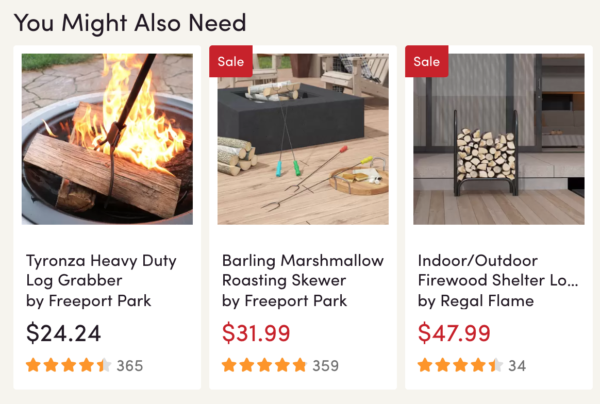
Don’t attempt to cross-sell items that cost more than the product itself. Buyers are looking at this particular product page for a reason, and price is a major factor.
Cross-selling at checkout
At this point in a customer’s shopping experience, you should focus on cross-selling lower-cost items. These could be small add-ons such as an accessory for the product being purchased or a specific-size battery the item may require.
For example, when you go to checkout with a bag of dog food in your cart on Chewy.com, the checkout page suggests purchasing a variety of affordable items, such as dog toys and pet shampoo, as illustrated below.
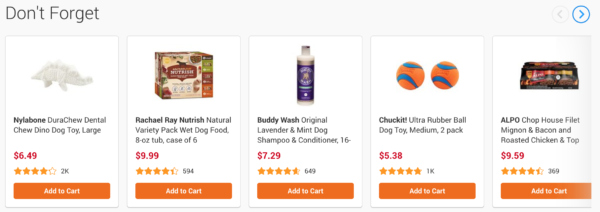
A good way to think about this is to imagine you’re at the grocery store checkout. When you’re already in line with the items you want, the store attempts to cross-sell to you by offering a variety of lower-priced products you can add to your cart, such as magazines, sodas, gum and candy.
Cross-selling for ecommerce: 6 tips to get started
1. Prioritize customer experience.
A potential downside to cross-selling for ecommerce is that it could annoy or frustrate customers, which is why it’s important to carefully consider how you cross-sell and what products you suggest to customers. Cross-selling should enhance a customer’s experience, so your cross-selling attempts should provide value and fulfill customer needs — not come across as a sleazy sales tactic. Check out this post by Zendesk to learn more about ethical selling and how the customer’s best interest is your best interest.
The key to doing this is to consider what would add value to your customer by keeping your product suggestions relevant. For example, suggesting a customer add a protection plan to a high-end item or purchase a power cord for a printer that doesn’t come with one is helpful and improves the shopping experience. Whereas suggesting a customer add an unrelated item or a more expensive item to their cart can rub a shopper the wrong way and even prompt them to abandon their purchase entirely.
In short, you want to help your customer, make it easy for them to say “yes,” and provide them with options that will make them feel like they’re getting a better deal.
2. Keep it simple.
Don’t giver a shopper too many additional products or services to choose from. Too many choices can actually overwhelm a customer, distract them from the item they were originally interested in, and make them less likely to make a purchase. This is known as choice overload, which can leave a buyer dissatisfied with their original potential purchase. And it can also cause what’s known as behavioral paralysis, which essentially means there are so many choices that a person can’t decide among them and opts to make no decision at all.
To avoid this, keep your cross-selling efforts limited to just a few products. For example, if a shopper is purchasing a book by a particular author, it makes sense to suggest one or two books by the same author or even a couple of similar titles based on the book’s subject or genre.
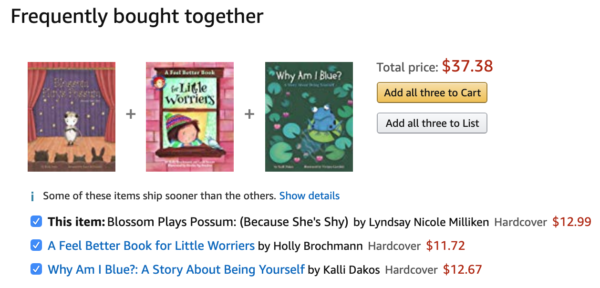
In the example above, visiting the product page for the picture book “Blossom Plays Possum: (Because She’s Shy)” results in Amazon suggesting similar children’s book titles. But Amazon suggests only two additional titles at similar price points so as not to overwhelm the buyer.
3. Start with your best-selling products.
When setting up cross-selling opportunities on your site, begin with your top-selling product and look for related or complementary products to suggest with it on the product page or at checkout. If it’s a high-priced item, consider how you could offer a service such as a protection plan or warranty.
Beginning with your most popular or flagship items is a great way to start cross-selling. These products are already getting a lot of traffic and attention, so you can experiment with various suggested products and services and determine which ones are getting added to your customers’ carts most often.
4. Try bundling.
Bundling is an effective way to cross-sell for ecommerce by packaging items that go well together so customers are aware of everything they may need to successfully use their purchase. For example, if a customer is interested in a digital camera, you can offer a bundle that includes the camera, a memory card, and camera strap.
You can even offer the bundled items at a discount if all the items are purchased together to make the bundle more appealing. In the example below, REI offers a Backpacking Bundle so consumers can purchase a tent, sleeping bag, and sleeping pad all together.
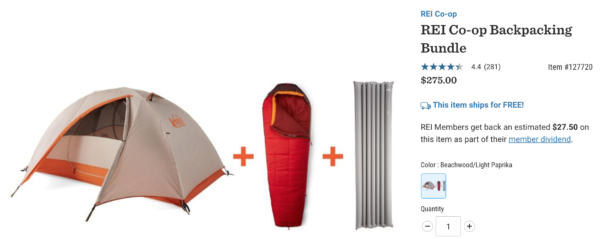
One of the most enticing things about a bundle is that the products are cheaper when purchased together, so be sure to emphasize how much a customer will save by opting for the bundle instead by including figures. For example, on the REI Backpacking Bundle product page, large text makes it clear that purchasing these three items together will save the buyer more than $ 60, as illustrated below.
![]()
Why does bundling work? According to psychology, it’s about perceived value. When multiple products are bundled together and sold as one, it appears more valuable to us and we’re often willing to spend a bit more to obtain it.
If you offer bundles in your online store, you can make them more effective by setting a minimum order for free shipping. Customers who arrive at your store planning to purchase a single item that doesn’t qualify for free shipping may switch to the bundled items in order to qualify for free shipping.
5. Use visuals.
Employ high-quality photos or videos to showcase products, explain how they work, and provide the customer with a close look at how the item can benefit them. This is a great opportunity for cross-selling because you can encourage buyers to add items to their carts by inviting them to “shop this look” or “shop this interior” and linking to other items for sale. This is especially effective for fashion and lifestyle products, such as in the example from Nordstrom below.
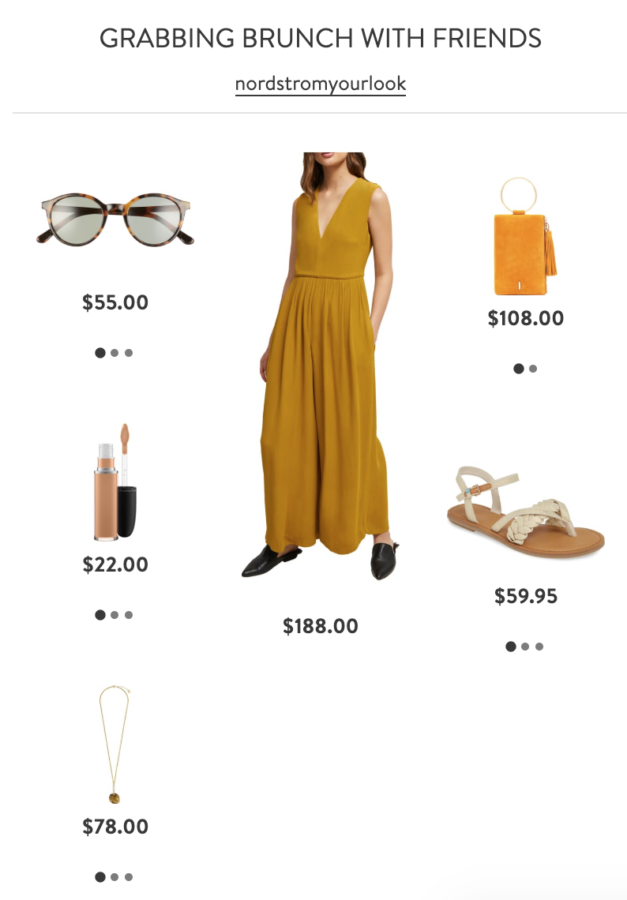
Why are visuals so effective in ecommerce? It all comes down to how the brain processes them. Check out this post by FollowUp to learn more about the science behind using images in ecommerce.
6. Demonstrate value.
Merely providing recommendations or cross-selling opportunities isn’t enough to show customers that there’s value in spending more with your brand. You need to actually prove to the buyer how the additional product or service you’re cross-selling is worthwhile.
You can do this by adding customer reviews to a product page, linking to case studies or data about how the product has benefited customers, or by using phrases like “customers also bought” or “popular related products” as evidence. You can even add customer testimonials or other things that demonstrate value to the email confirmation of purchase to reinforce this.
The key to effectively doing this is to make the value in adding more items to the cart immediately clear to a customer without being pushy. This way, buyers are making the decision to spend more on their own, and they’ll feel more confident in their decision.
Start cross-selling for ecommerce
Now that you understand cross-selling and how it can increase your average order size and grow your revenue, it’s time to get started.
Begin by identifying which products you’ll focus on first and then determine how you’ll ask customers if they’d “like fries with that.” In other words, what related products, complementary products or services can you suggest to a shopper that’ll add value to their purchase or improve their experience?
As you experiment with different methods of cross-selling, continue to test and improve your strategies to see what works best for your store and your customers.
Digital & Social Articles on Business 2 Community
(113)
Report Post